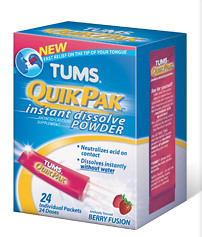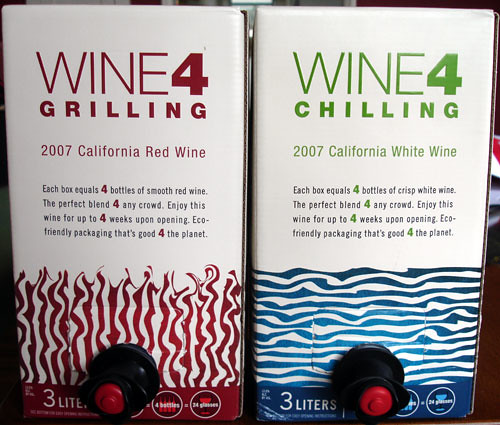I just saw a new product being advertised, the Tums Quik Pak, a 24-pack of plastic envelopes filled with antacid that, “delivers the strength of two regular TUMS tablets in a small amount of great-tasting powder.” Hey, I know a way you can get the same effective medication delivered as a great-tasting powder – chew two Tums tablets. How ridiculous is that? More packaging and waste for the same chalky product and it costs four times as much. It’s like you’re paying them extra money to not press it into a tablet.

This is the problem with American consumerism. It’s all about packaging and waste. With food shortages, rising oil prices and increased pollution, we should be focusing on conservation. No politicians talk about that because then we constituents might be inconvenienced. We might have to use public transportation. Or buy foods that aren’t metered out in prepackaged individual serving sizes. Or, as they do in other countries, pay for your shopping bags. But instead, we’ve created a culture of convenience and “freedom.” That I can choose between 18 different Coca-Cola beverages in 6 oz, 12 oz, 16 oz, 20 oz, 24 oz, 1 liter and 2 liter sizes does not make me feel liberated.
So in my life I’ve tried to reduce my consumption, which is why I’m always keen to try a new boxed wine. How does stuffing four bottles of wine in a plastic bag packed in a cardboard box help reduce consumption? It’s much lighter transporting the same amount of wine costs less, it takes up less space and it keeps wine fresher. And sure, a plastic bag uses fossil fuels, but so does recycling glass. So yesterday, I was in Cost Plus when I saw they were hocking two new boxed wines, Wine 4 Grilling (red) and Wine 4 Chilling (white).

Closer inspection showed that these wines were made exclusively for Cost Plus by the Trinchero Winery, a mass-market winery in Napa that also makes some of the boxed wines for Target. At $14.99/3-liter box, it was a bit cheaper than the Target wines. I bought them, figuring that if they were the same wines in a less pretty box, I could at least get the same buzz for a couple bucks cheaper. But I spoke to Mark Gallo of Trinchero, who explained that the wines were focused at a different price point and were formulated from different grape sources to fit that criterion.
The wines are definitely cut from the same swathe as the Target wines – fruit forward, soft tannins – but as a whole, I found them much more drinkable and interesting. The Wine 4 Chilling (I don’t name it, I just drink it) is a blend of Chardonnay, Moscato and Chenin Blanc. It has peachy, floral notes on the nose from the Moscato, very pleasant. The wine itself is a little flabby and fruity and there’s a touch of tight bitterness on the finish that’s not unpleasant, but not necessarily welcome. It’s pretty similar to the Target white blend, but with less of that Sweet Tart thing going on. It’s drinkable, but the colder it is, the better.
The Wine 4 Grilling is good for more than just backyard barbecue. Despite it having almost no nose (it could be my allergies), it’s surprisingly drinkable. It’s a blend of Zinfandel, Merlot and Cabernet Sauvignon and you can taste all three. The briar fruits that Zin brings are there up front followed by the softness of Merlot on the tongue and there is a healthy amount of Cab tannins on the back end. It’s not terribly complex and these days, I prefer my wines with a bit more acid, but it’s perfect for everyday drinking. At what comes out to be less than $4/bottle, it’s a real bargain.
Plus, as the packaging is made from 30% post consumer materials and both bag and box are recyclable, I like to think that by drinking it I’m doing my part to help the environment. As for conservation, I’ll do that with my gasoline and antacid packaging, but I won’t do that with my wine.
 I should start off by saying that I have a fairly good palate for wine. I have been lucky enough to have access to some fantastic wines and while I don't drink first growth Bordeaux every weekend, I taste a few hundred different wines a year, a couple of which one might consider hoity toity. So I know my Barolos from my Barberas d'Alba. But I'm also not a snob. Good wine is good wine.
Which brings me to the box. My first real encounter with boxed wines was in Montreal, where their wine consumption per capita is probably much higher than ours. I remember being surprised at how tasty it was (it was a Frenchy wine). Boxed wine is
I should start off by saying that I have a fairly good palate for wine. I have been lucky enough to have access to some fantastic wines and while I don't drink first growth Bordeaux every weekend, I taste a few hundred different wines a year, a couple of which one might consider hoity toity. So I know my Barolos from my Barberas d'Alba. But I'm also not a snob. Good wine is good wine.
Which brings me to the box. My first real encounter with boxed wines was in Montreal, where their wine consumption per capita is probably much higher than ours. I remember being surprised at how tasty it was (it was a Frenchy wine). Boxed wine is